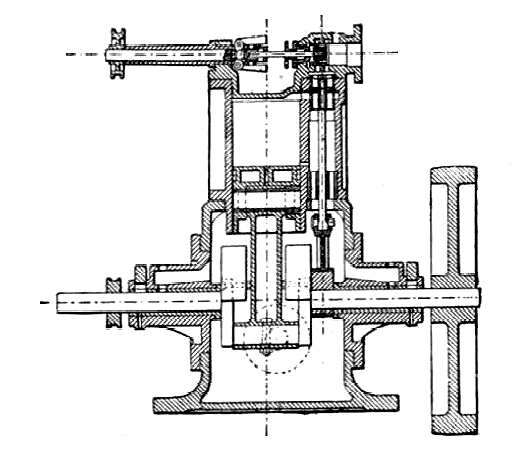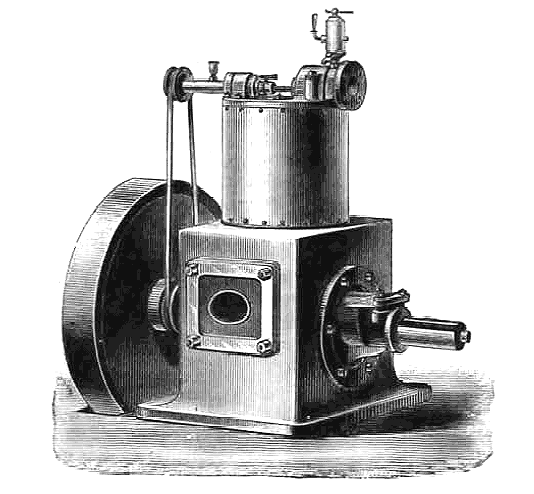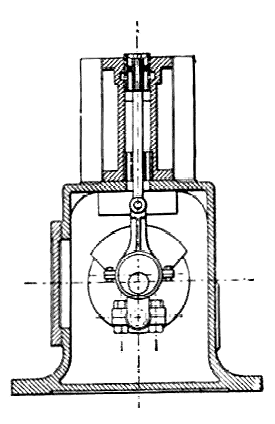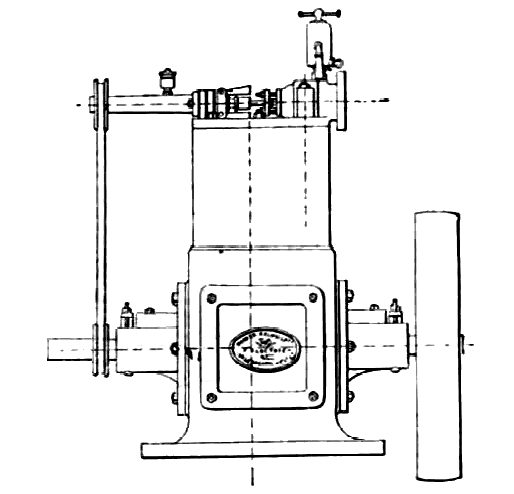|
Elwell and
Parker’s Patent Engine
In our recent notice of the Royal
Agricultural Society's Show at Shrewsbury we referred to an
exhibit by the Coalbrookdale Company of a high-speed engine, of
which it is the sole makers, invented by Messrs. Elwell and
Parker of Wolverhampton, and named the Electric, and we are now
enabled to lay further particulars and illustrations before our
readers. The engine, although of the ordinary single-acting
type, presents some features of novelty, and its performances
are such as to justify us in saying that for simplicity of
mechanism, good arrangement of details, substantial design and
high class workmanship, it approaches very near to the ideal of
a high-speed machine.
 |
The particular engine which is the subject of our
illustrations has a 10 inch cylinder, 9 inch stroke, and
is arranged to run at 500 revolutions per minute.
This is by no means the highest speed at which it
will run, but the company, wisely, does not recommend
excessive velocities, as the difference in the power
given on the brake and that shown on the diagram becomes
so great, owing to the rapid increase of friction, as to
seriously detract from the efficiency and economy of the
engine. |
It will be seen on reference to the
illustration that the engine differs from many of the same class
by the fact of its having only one cylinder, an arrangement
which, it is claimed, without sacrificing steady running, very
greatly lessens the number of working parts, reducing the wear
and tear to a minimum, and simplifying the whole machine. The
cylinder is mounted on a base of box form, which encloses the
working parts, and into which the exhaust steam passes. It is
provided with circular facings on each side for the two side
covers forming the main bearings, a square cover for access to
the interior, and the exhaust outlet. The position of the latter
plays an important part in the working of the engine, as upon
this the efficient lubrication depends.
| The exhaust steam condenses slightly as it passes
through the base, and the water with the oil floating on
the top of it accumulates and rises up to the level of
the outlet.
Before, however, it quite reaches this height, the
connecting-rod end is arranged to dip into it at each
stroke, which splashes the oil and water over the whole
of the moving parts.
The main bearings are of very ample length, and
fitted with phosphor bronze bushes. |
 |
A passage is cast in the cover above the
bush which catches the oil and water and conducts it to the
outer end of the bearing, from whence it circulates back along
the usual oil grooves into the base again. A small stuffing box
and half-round gland serve to prevent any leakage to the
outside. The crank shaft is of forged steel, and the balance
weights are dovetailed on, and securely bolted.
The slide valve is of the piston type, of
novel construction, It consists of three rings, united to each
other and to a central boss by webs, the central ring forming a
diaphragm to divide the steam and exhaust ports; the other two
forming guides, which prevent the cutting of the edges of the
ports. A valve of this character is found to work quite tight
without any spring rings, and remain so after a large amount of
use. The passages are designed to allow a maximum speed of
5,000ft, per minute for the steam, the exhaust being enlarged as
much as possible, and an auxiliary port formed at the lower end
of the cylinder, to be uncovered by the piston in its travel.
 |
We have now before us diagrams taken from this
engine at various speeds showing a very good
distribution of steam, which should go far to overcome
the objections often raised against this class of engine
on the score of economy. The governor is placed
horizontally across the cylinder cover, operating an
equilibrium valve in the steam pipe, and is made
extremely sensitive in its action by a very neat device
adjustable to any required speed. The driving shaft is
carried by a phosphor bronze bush, bolted to the cover,
at the outer end of which is the driving pulley. The
lubricator, which supplies oil to the whole of the
engine, with the exception of the governor spindle,
stands on the steam pipe.
Speaking generally of the engine, we may say that the
whole of the flanges and phosphor bronze bushes are
bright, and fitted with bright nuts; the flywheel is
turned and polished, and the cylinder lagged with sheet
steel, forming a very handsome and compact piece of
workmanship. The castings are of an exceptionally clean
and perfect character. |
| These engines have up to the present been
principally supplied to the inventors, Messrs. Elwell
and Parker of Wolverhampton, for use in conjunction with
their dynamos and accumulators, where they have been a
great success. We may mention, in conclusion, that the
Coalbrookdale Company is now engaged in re-arranging and
adding to its engineering department, in which, when
finished, it will be able to deal with work of the
heaviest and highest class. |
 |
|